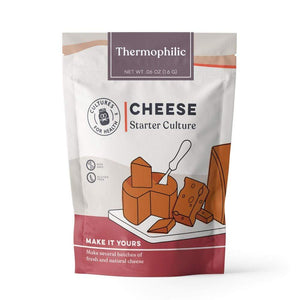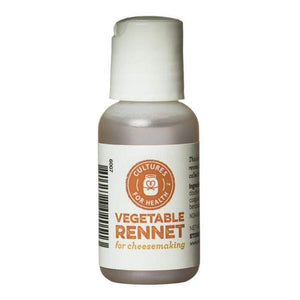
Provolone is a “pulled” cheese, like mozzarella. It is also traditionally smoked, in the original Italian style. But today most provolone is generally made much milder and less overpowering.
30 minutes
48 minutes
4
INGREDIENTS AND EQUIPMENT AVAILABLE AT CULTURES FOR HEALTH
Fresh Cheese Making Kit

Fresh Cheese Making Kit
$45.99
Our most comprehensive choice, the Fresh Cheese Kit contains two starter cultures and supplies to make five different varieties of soft cheese - feta, cottage cheese, cream cheese, fromage blanc, and traditional quark. Kit contains a Mesophilic Cheese Culture, a Fresh Cheese Culture, calcium chloride, vegetable rennet, cheese salt, butter muslin, a thermometer, and an instruction and recipe booklet.
Packaging and Equipment in the kit may appear different than pictured.
Thermophilic Starter Culture

Thermophilic Starter Culture
$12.99
This useful culture makes a variety of hard cheeses, including parmesan, romano, provolone, and swiss.
Liquid Vegetable Rennet

Liquid Vegetable Rennet
$5.99
Double-strength liquid vegetable rennet. Each bottle contains enough rennet to set (24) 2-gallon batches of cheese.
Cheese Salt

INGREDIENTS:
- 1 gallon pasteurized whole milk
- 1 packet thermophilic starter
- 1/4 tsp. lipase powder dissolved in 1/4 cup cool water
- 1/4 tsp. liquid rennet dissolved in 1/4 tsp. cool water
- 2 Lbs. cheese salt
- 1 gallon cold water
INSTRUCTIONS:
- Heat the milk to 97°F.
- Add the starter and mix in well, using a cheese spoon in up-and-down motions, for 1 full minute. Cover the milk and allow to ripen undisturbed for 1 hour, continuing to maintain the temperature at 97°F.
- Add the dissolved lipase mixture, and mix in well. Allow the milk to rest for 10 minutes.
- Add the diluted rennet and stir it in well using the same up-and-down motions used for incorporating the starter, continuing to stir for 1 full minute. Cover and let the milk set for 20 minutes, undisturbed.
- Once there is a clean break, cut the curds into 3/8-inch cubes. Allow the cut curds to rest for 10 minutes after cutting.
- Begin heating the curds while stirring them very gently, bringing the temperature up only 2°F per minute until the temperature reaches 144°F. Turn off the heat and allow the curds to sit for 15 minutes.
- Scoop all the curds out of the whey and place them into a clean colander, then set that colander over the pot of warm whey to help keep the temperature of the curds up to at least 105°F while they rest for 30 more minutes.
- Take a small piece of curd and dip it into clean water that has been heated to 180°F . Pull it a bit, and if it does not stretch, place it back into the colander and try again every 15 minutes until it does. (This can take a long time, so be patient.) Once the curd stretches smooth and shiny, start cutting the curd into 1-inch slices and placing them into the hot water. Let them sit in the water until all of them stretch easily.
- Using gloved hands, stretch the curds, and form the entire mass into a large ball. Begin to shape the ball into a jug shape, with one end smaller than the rest. At the top, where the opening of the jug would be, make a small indention and being working the curd up the neck of the jug shape and into the indention. If the curd gets hard to work with, dip it back into the hot water.
- After working the cheese, place it in a bowl of ice water. Meanwhile, make a brine using 2 pounds of salt mixed into 1 gallon of water, and chill it.
- Take the cheese out of the ice water and place it into the brine, and leave it to soak for 2 hours.
- Take the cheese out of the brine and pat dry using paper towels. Tie a cord around the small end of the cheese and hang in the ripening area, such as a cellar or refrigerator, for 2 to 12 months, or until you are ready to eat it. (This cheese may be cold-smoked before hanging, if desired.
















